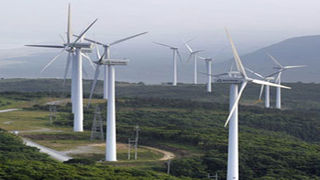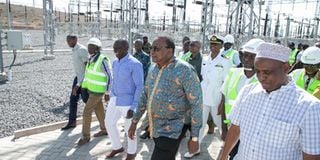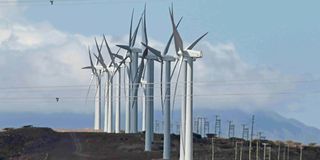
The Lake Turkana Wind Power project.
| FileCompanies
Premium
The Loiyangalani wind project that became a living nightmare
It started like all the good plans do: a dream. The plan? To transform Kenya’s energy economy, make its power generation environmentally sustainable and position Kenya as a continental leader in wind energy. Sounds cool, right? Wrong.
The whole enterprise, from conception to execution, was crafted from the start to rob taxpayers of billions of shillings through phony contracts with the country’s power distributor.
This is the short but sad story of the Lake Turkana Wind Power project, Kenya’s biggest wind power project. Seventeen years since it was conceived, this shining piece of engineering in the Loiyangalani wilderness has become a source of unbearable pain to Kenyans through a series of decisions that read like the script of a horror movie.

Picture this: Lake Turkana Wind Power is a strategic contract that allows it to be in charge of hiring other key partners in delivering the mega power project; and the same contract allows it to claim handsome earnings in hefty penalties in case of any delays. The company goes looking for a company on the brink of bankruptcy to do the job. The hired company is given Sh10.8 billion to build a transmission line. Shortly afterwards it conveniently goes bankrupt, causing the project an expensive 21-month delay. The delay is music to the ears of the wind firm, which makes nearly Sh18.5 billion from generating no power.
What’s more, the company also makes Value Added Tax (VAT) claims of Sh2.7 billion. And the government pays on its behalf. A new company is contracted to finish the job, but it demands, and gets, an additional Sh3.1 billion. Then there are other accrued penalties of Sh1.7 billion slapped on the taxpayer by the new contractor, earning interest for every day not paid. In total, about Sh37 billion goes down the drain.

President Uhuru Kenyatta unveils a commemorative plaque during the ground breaking ceremony of the Lake Turkana Wind Power project.
The icing on the cake? The company has committed no crime. No one is held accountable as Kenyans start paying for these mistakes, a decade later, through additional tariffs loaded on their monthly power bills.
The dream carrier was the Lake Turkana Wind Power (LTWP) company, a firm owned by at least seven local and multinational investors. It was also backed by solid lenders who handed it billions of shillings to actualise the dream. In return, they received an annual loan repayment of Sh8.5 billion from the project.
This was way before 2004, way before Kenya became a global powerhouse in geothermal generation. At that time, getting 300MW of wind power from the Loiyangalani desert was a dream come true.

Wind turbines at the Lake Turkana Wind Power project on July 19, 2019.
But first, the wind company, whose board has been chaired by former Vision 2030 director-general Mugo Kibati, a man who had made his name marketing Kenya’s 30-year growth plan, needed land. Nowhere else showed more promise for the project than Loiyangalani in Marsabit County.
In 2005 the firm easily secured a 99-year lease for 40,000 acres, or about 160 square kilometers, in the desert from the Kenyan government, with effect from 2005. Shortly afterwards, the wind company contracted DEWI, an international wind energy consulting firm, to carry out wind tests on the land. The company submitted the test results and proposal to the Government of Kenya in April 2006. Everything was going as planned. Several years later, DEWI would be acquired by Underwriters Laboratories (UL), a global independent safety science company headquartered in Illinois in the United States.
With the tests complete, the company came to the government with a final proposal to construct a wind power plant and sell the energy generated to Kenya Power. At the time, the project was being marketed as one that would increase Kenya’s national power generation by 17 per cent.
The Kenya Power board of directors at the time sat on November 4, 2009 and swiftly approved the decision to engage Lake Turkana Wind Power through a power purchase agreement to sell 300MW to Kenya Power. Four days after this board meeting, Kenya Power wrote to the Energy and Petroleum Regulatory Authority (EPRA), at the time known as the Energy Regulatory Commission (ERC).
In the letter dated November 9, 2009, Kenya Power asks the regulator to approve the Power Purchase Agreement (PPA). There were no delays. The approval was granted within a record two days. The wind power company, as a private entity, consequently entered into a contract with Kenya Power on January 29, 2010.
According to the power purchase agreement, Lake Turkana Wind Power was to finance, design, procure, construct, install, test, commission, operate and maintain the plant. It would then sell the net electrical output exclusively to Kenya Power. On the other hand, Kenya Power was to take delivery of all net electrical output and pay energy charges for such output. The power purchase agreement also required Kenya Power to purchase power generated by the company for a period of 20 years from the date of the first commissioning of the wind power plant.
“The special audit, therefore, notes with concern that a Power Purchase Agreement was executed between Lake Turkana Wind Power and Kenya Power on 29 January 2010, before Lake Turkana Wind Power had obtained a license to generate electric power, which was granted almost a year later on December 16, 2010 after the Power Purchase Agreement was executed,” the Auditor-General notes in part.
The audit also notes that the PPA was guided by the Feed-in-Tariff policy which allowed power producers to sell electricity to Kenya Power at a predetermined tariff for a given period. The firm was, therefore, to produce 300MW and sell at a rate of Sh7.65 per kilowatt (Kwh). The price was lower than the EPRA-recommended Sh11.
At the time of executing the power purchase agreement, the managing director of Kenya Power was Mr Joseph Njoroge, who was until last week the Principal Secretary in the Energy ministry. He was moved to the Transport docket on the day President Uhuru Kenyatta started the process of cutting off the expensive Independent Power Producers (IPPs), who have for decades been responsible for Kenya’s expensive power, from the national grid.
Also on the driving seat was Mr Patrick Nyoike, who was the Energy Permanent Secretary at the time. The Auditor-General says that Mr Nyoike, who was also a board member of Kenya Power, was also a member of the team responsible for sourcing and engaging the wind firm.
At the time, the project location in Loiyangalani was not serviced by any transmission line network. That was when the problems began and a good dream turned into a nightmare that has refused to go away as taxpayers face hefty penalties for power that was never generated or consumed.
In order to supply the power to the national grid for uptake by Kenya Power as was envisaged in the power purchase agreement, there was a need for developing a transmission line from Loiyangalani to Suswa, where the wind farm was to connect to the national grid. The Energy ministry was to construct a 400 kilovolts (KV) sub-station near Loiyangalani and a 428-kilometre transmission line from Loiyangalani to Suswa to realise the project.
But before the transmission scandal started, the Energy ministry broke other laws. The special audit found that it granted the private company the exclusive rights to survey the project area and wind resources and further invite tenders on behalf of Kenya Power, which the Auditor-General has now found illegal.
Ms Gathungu notes that the procurement law provides for circumstances under which direct procurements may be used, which is urgency and lack of reasonable alternatives, and “none of these were justified to warrant the handpicking process” by the Ministry of Energy”.
“The special audit confirmed that the process was contrary to Section 3(2) of the Public Procurement and Disposal (Public-Private Partnerships) Regulations, 2009 as there was no competitive bidding for this potential Public-Private Partnerships arrangement, and neither was there any justification for such an exception,” she notes.
But as the ink dried on the contract, the wind power company went on with its business. It had broken no laws. Thus, it would be involved in the financing, designing, procuring, constructing, installing, testing, commissioning, operating and maintening of the plant. It completed the power generation plant on January 27, 2017.
“In addition, they were involved in part of the procurement process (invitation to tender), supposedly on behalf of Kenya Power for Lot 3: 400kv transmission line from Loiyangalani to Suswa, which was a red flag and potential conflict of interest,” the special audit reveals.
Ironically, the company is the one that procured South African firm Isolux Ingenieria SA and KEMA, the consultant for the project. How the company was handed the Sh17.3 billion contract to build the transmission line without due diligence continues to puzzle government officials to date. Conveniently, Isolux would go bankrupt shortly afterwards, resulting in massive delays that eventually benefited the wind firm via the hefty fines it loaded on the government.
“M/s Isolux Ingenieria SA, and the Consultant KEMA, both who had been procured by Lake Turkana Wind Power, were the key players in determining the success of the transmission line, yet Lake Turkana Wind Power was the eventual beneficiary of the delays in completion of the project by way of TI interruption DGE payments,” notes the auditor.
Payments also began without any independent review to confirm the readiness of power generation by Lake Turkana Wind Power. Curiously, the company has also not installed a metering system to measure total production units as required in the contract. This made it difficult to determine accurately the production and purported energy charges.
Tomorrow in the ‘Sunday Nation’: The World Bank warnings about Lake Turkana Wind Power that fell on deaf ears, the Bank’s fast exit from the project, and the scandal of one million electricity metres that have vanished from Kenya Power warehouses.





